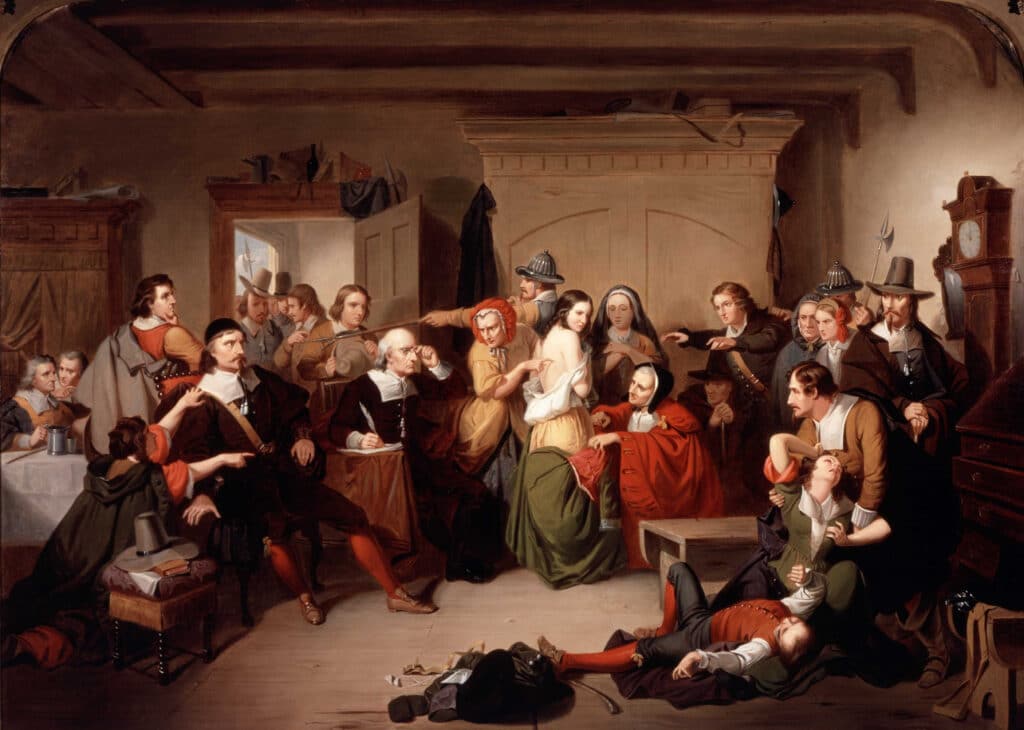Elizabeth Proctor was one of the victims who were accused and sentenced to be executed during the Salem Witch Trials. She, along with her husband John Proctor, were found guilty of witchcraft. However, due to her being pregnant, her execution was delayed, and she was eventually released from prison by Governor William Phips.
Elizabeth Proctor remarried in 1699 to Daniel Richards. In 1703, she and her late husband, John Proctor, were granted a reversal of attainder by the Massachusetts legislature.
Early Life and Family
Elizabeth was born to Captain William Bassett Sr. and Sarah Burt in 1650. Her parents had migrated from England to Massachusetts Bay Colony, which made her a native-born colonist.
She grew up in Lynn, Massachusetts Bay, until she married John Proctor in 1674 and then moved to Salem.
John had been married twice before Elizabeth, and both of his wives had passed away. The Proctors were one of the wealthier citizens in the area and
Elizabeth's grandmother was Ann (Holland) Bassett Burt, a Quaker and a midwife. The Puritans felt there was something "witchlike" about Quakers.
Since Ann was not a doctor but was successful at caring for those who were ill, some felt she could only have these skills if she were a witch.
She was charged with witchcraft in 1669. One of those who testified against Ann was Phillip Read, a doctor. These accusations left a taint in the memories of residents and may have contributed to Elizabeth's persecution nearly 30 years later.
Accusation and Trial
The Proctor's servant girl, Mary Warren, began to have fits and claim to be afflicted by the specter of Giles Corey. John Proctor dismissed this claim and believed it to be nonsense. Proctor believed that witchcraft should be suspected of the bewitched girls themselves and not of the respectable women of the village.
His belief that it was a farce made his wife an easy target. He underestimated the power of the hysteria that was beginning to surface in the village.
The first accusations came against Elizabeth on March 26, 1692, when Mercy Lewis claimed that Elizabeth was afflicting her.
William Rayment, of nearby Beverly, Massachusetts, mentioned he had heard a rumor that Elizabeth Proctor would be questioned in court the next day. Appearing to go into a trance, one of the girls cried, "There’s Goody Proctor! Old Witch! I’ll have her hung."
When folks expressed doubt, claiming that the Proctor family was well regarded in the community, the girl promptly came out of her trance and told them it was all for "sport".
Another round of accusations came three days later when Abigail Williams and Mercy Lewis said they were being tormented. A few days after the initial accusation, Abigail claimed that Elizabeth was pinching her and tearing at her bowels. She then said she saw Elizabeth and John's specter.
In response, 31 men from Ipswich, Massachusetts, filed a petition attesting to the upstanding character of the couple and stated that there was no evidence that the two of them were witches.
In May 1692, a similar petition was filed on behalf of John and Elizabeth, containing signatures of 20 men and women, including several of the wealthiest landowners of Topsfield, Massachusetts, and Salem Village. The petition questioned the validity of spectral evidence, testified to the Christian lives that John and Elizabeth had led, said that they “were ever ready to help such as stood in need of their help,” and that the petitioners had no reason to believe the couple was witches.
On June 2, 1692, a male doctor and several women completed a physical examination of Elizabeth and several of the other accused. They looked for birth defects, moles, or other markings, which were widely believed at the time to be a sign that the person was a witch; the examiners found no such marks.

On August 2, 1692, the court met in Salem to discuss the fate of John, Elizabeth, and several others. At some point during this time, John wrote his will, but he did not include Elizabeth. Some believe this is because he assumed she would be executed along with him.
In spite of the petitions and testimonies from friends, both John and Elizabeth were found guilty and were sentenced to death on August 5, 1692. Elizabeth, who was pregnant at the time, was granted a stay of execution until after the birth of the baby. John tried to postpone his execution but failed.
On August 19, 1692, John was executed. Elizabeth remained in jail. The action was eventually taken on the petition that John had filed to save his life and that of Elizabeth, but it was too late for him.
After the final mass executions on September 22, 1692, Governor Phips became much more active in the Salem Witch Trials. He replaced the court and forbade the use of spectral evidence. He also began releasing those that had been convicted and were waiting for their sentence. However, Elizabeth remained in prison until May 1693, when the girls tried to accuse Governor Phip's wife of witchcraft, and in response, he released all prisoners still being held.
Upon release, Elizabeth could not return home. She had still been convicted as a witch, and the stigma stayed with her.
Over time, she was able to get remarried and find financial relief, but it was a struggle until the end for her. It appears that she moved away from Salem, and it is unknown where and when she died.
This ends her chapter in one of the most tragic moments in Colonial America.
